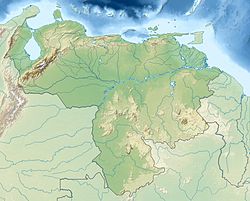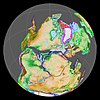| La Quinta Formation | |
|---|---|
| Stratigraphic range: Hettangian—Aalenian | |
 | |
| Type | Geological formation |
| Underlies | Río Negro Formation |
| Overlies | Mucuchachi Formation |
| Thickness | up to 11,000 ft (3,400 m) |
| Lithology | |
| Primary | Sandstone |
| Other | Tuff, conglomerate |
| Location | |
| Coordinates | 8°09′N 72°01′W / 8.15°N 72.02°W |
| Approximate paleocoordinates | 0°06′N 42°42′W / 0.1°N 42.7°W |
| Region | Cesar-Ranchería & Maracaibo Basins Serranía del Perijá & Cordillera de Mérida |
| Country | |
| Type section | |
| Named for | La Quinta quarry |
The La Quinta Formation is a Jurassic geologic formation which crops out in the Cordillera de Mérida and Serranía del Perijá of western Venezuela and northeastern Colombia. The formation is also present in the subsurface of the Cesar-Ranchería and Maracaibo Basins. At its type locality near La Grita, Táchira, it consists of a basal dacitic tuff followed by interlayered sandstones, tuffs, siltstones and rare limestones.[1] Dinosaur remains including Laquintasaura,[2] Tachiraptor, and Perijasaurus[3] are among the fossils that have been recovered from the formation.[4]
U–Pb zircon analysis demonstrates that the formation dates to 200.91+0.55 Ma at its base[2] and a maximum age of 174.8 Ma.[3]
Paleofauna
[edit]| Genus | Species | location | Material | Notes | Images |
|---|---|---|---|---|---|
| Laquintasaura[2] | L. venezuelae | Partial skeleton | First dinosaur identified from Venezuela | ||
|
P. lapaz |
Partial dorsal vertebra | Previously known as the "Cesar sauropod", and was the first dinosaur discovered in Colombia | |||
| T. admirabilis | Venezuela | A tibia and ischium |
Regional correlations
[edit]- Legend
- group
- important formation
- fossiliferous formation
- minor formation
- (age in Ma)
- proximal Llanos (Medina)[note 1]
- distal Llanos (Saltarin 1A well)[note 2]
See also
[edit]Notes
[edit]References
[edit]- ^ Barret et al., 2008, p.164
- ^ a b c Barret et al., 2014
- ^ a b Rincón AF, Raad Pájaro DA, Jiménez Velandia HF, Ezcurra MD, Wilson Mantilla JA (2022). "A sauropod from the Lower Jurassic La Quinta Formation (Dept. Cesar, Colombia) and the initial diversification of eusauropods at low latitudes". Journal of Vertebrate Paleontology. 42 (1): e2077112. Bibcode:2022JVPal..42E7112R. doi:10.1080/02724634.2021.2077112. S2CID 251501541.
- ^ Weishampel, et al. (2004). "Dinosaur distribution." Pp. 517-607
- ^ a b c d e f García González et al., 2009, p.27
- ^ a b c d e f García González et al., 2009, p.50
- ^ a b García González et al., 2009, p.85
- ^ a b c d e f g h i j Barrero et al., 2007, p.60
- ^ a b c d e f g h Barrero et al., 2007, p.58
- ^ Plancha 111, 2001, p.29
- ^ a b Plancha 177, 2015, p.39
- ^ a b Plancha 111, 2001, p.26
- ^ Plancha 111, 2001, p.24
- ^ Plancha 111, 2001, p.23
- ^ a b Pulido & Gómez, 2001, p.32
- ^ Pulido & Gómez, 2001, p.30
- ^ a b Pulido & Gómez, 2001, pp.21-26
- ^ Pulido & Gómez, 2001, p.28
- ^ Correa Martínez et al., 2019, p.49
- ^ Plancha 303, 2002, p.27
- ^ Terraza et al., 2008, p.22
- ^ Plancha 229, 2015, pp.46-55
- ^ Plancha 303, 2002, p.26
- ^ Moreno Sánchez et al., 2009, p.53
- ^ Mantilla Figueroa et al., 2015, p.43
- ^ Manosalva Sánchez et al., 2017, p.84
- ^ a b Plancha 303, 2002, p.24
- ^ a b Mantilla Figueroa et al., 2015, p.42
- ^ Arango Mejía et al., 2012, p.25
- ^ Plancha 350, 2011, p.49
- ^ Pulido & Gómez, 2001, pp.17-21
- ^ Plancha 111, 2001, p.13
- ^ Plancha 303, 2002, p.23
- ^ Plancha 348, 2015, p.38
- ^ Planchas 367-414, 2003, p.35
- ^ Toro Toro et al., 2014, p.22
- ^ Plancha 303, 2002, p.21
- ^ a b c d Bonilla et al., 2016, p.19
- ^ Gómez Tapias et al., 2015, p.209
- ^ a b Bonilla et al., 2016, p.22
- ^ a b Duarte et al., 2019
- ^ García González et al., 2009
- ^ Pulido & Gómez, 2001
- ^ García González et al., 2009, p.60
Bibliography
[edit]- Barrett, Paul M.; Butler, Richard J.; Mundil, Roland; Scheyer, Torsten M.; Irmis, Randall B.; Sánchez-Villagra, Marcelo R. (2014), "A palaeoequatorial ornithischian and new constraints on early dinosaur diversification" (PDF), Proceedings of the Royal Society B, 281 (1791), Royal Society: 1–7, doi:10.1098/rspb.2014.1147, PMC 4132680, PMID 25100698, retrieved 2018-08-18
- Barrett, P. M., R. J. Butler, S. C. Moore-Fay, F. E. Novas, J. M. Moody, J. M. Clark, and M. R. Sänchez-Villagra. ‘Dinosaur Remains from the La Quinta Formation (Lower or Middle Jurassic) of the Venezuelan Andes’. Paläontologische Zeitschrift 82, no. 2 (2008): 163–177.
- Weishampel, David B.; Dodson, Peter; and Osmólska, Halszka (eds.): The Dinosauria, 2nd, Berkeley: University of California Press. 861 pp. ISBN 0-520-24209-2.
Maps
[edit]- Colmenares, Fabio; Mesa, Milena; Roncancio, Jairo; Arciniegas, Edgar; Pedraza, Pablo; Cardona, Agustín; Silva, César; Romero, Jhoamna; Alvarado and Oscar Romero, Felipe Vargas, Carlos Santamaría, Sonia (2007), Plancha 14 - Albania - 1:100,000, INGEOMINAS, p. 1, retrieved 2017-06-06
{{citation}}: CS1 maint: multiple names: authors list (link) - Colmenares, Fabio; Mesa, Milena; Roncancio, Jairo; Arciniegas, Edgar; Pedraza, Pablo; Cardona, Agustín; Silva, César; Romero, Jhoamna; Alvarado and Oscar Romero, Felipe Vargas, Carlos Santamaría, Sonia (2007), Plancha 21 - Fonseca - 1:100,000, INGEOMINAS, p. 1, retrieved 2017-06-06
{{citation}}: CS1 maint: multiple names: authors list (link) - Colmenares, Fabio; Mesa, Milena; Roncancio, Jairo; Arciniegas, Edgar; Pedraza, Pablo; Cardona, Agustín; Silva, César; Romero, Jhoamna; Alvarado and Oscar Romero, Felipe Vargas, Carlos Santamaría, Sonia (2007), Plancha 34 - Agustín Codazzi - 1:100,000, INGEOMINAS, p. 1, retrieved 2017-06-06
{{citation}}: CS1 maint: multiple names: authors list (link) - González, Javier; Clavijo, Jairo; Hernández, Marina; García, Carlos (2002), Plancha 40 - Bosconia - 1:100,000, INGEOMINAS, p. 1, retrieved 2017-06-06
- Hernández, Marina; Clavijo, Jairo; González, Javier (2001), Plancha 47 - Chiriguaná - 1:100,000, INGEOMINAS, p. 1, retrieved 2017-06-06
- Hernández, Marina; Clavijo, Jairo (2008), Plancha 48 - La Jagua de Ibirico - 1:100,000, INGEOMINAS, p. 1, retrieved 2017-06-06

























